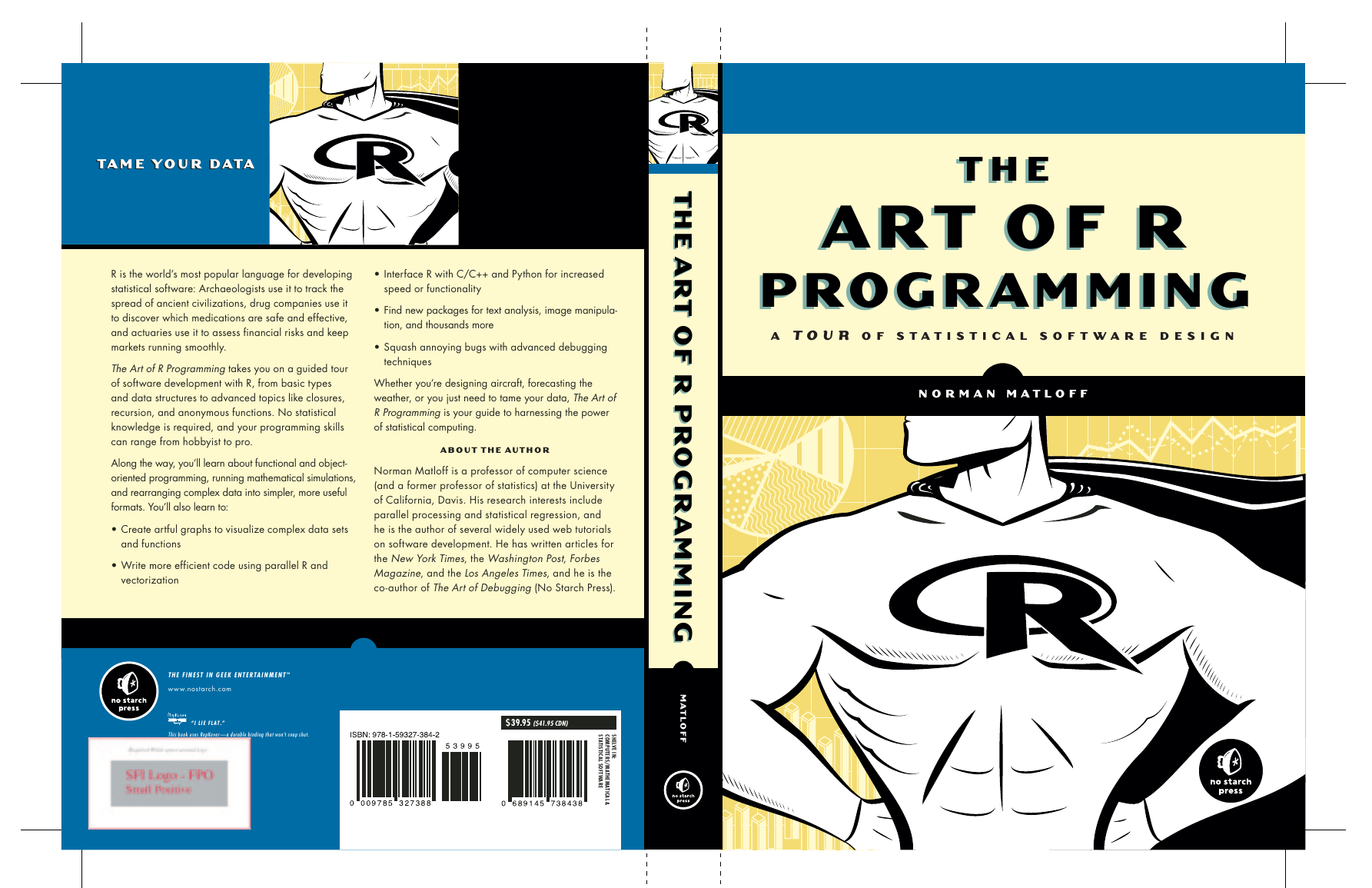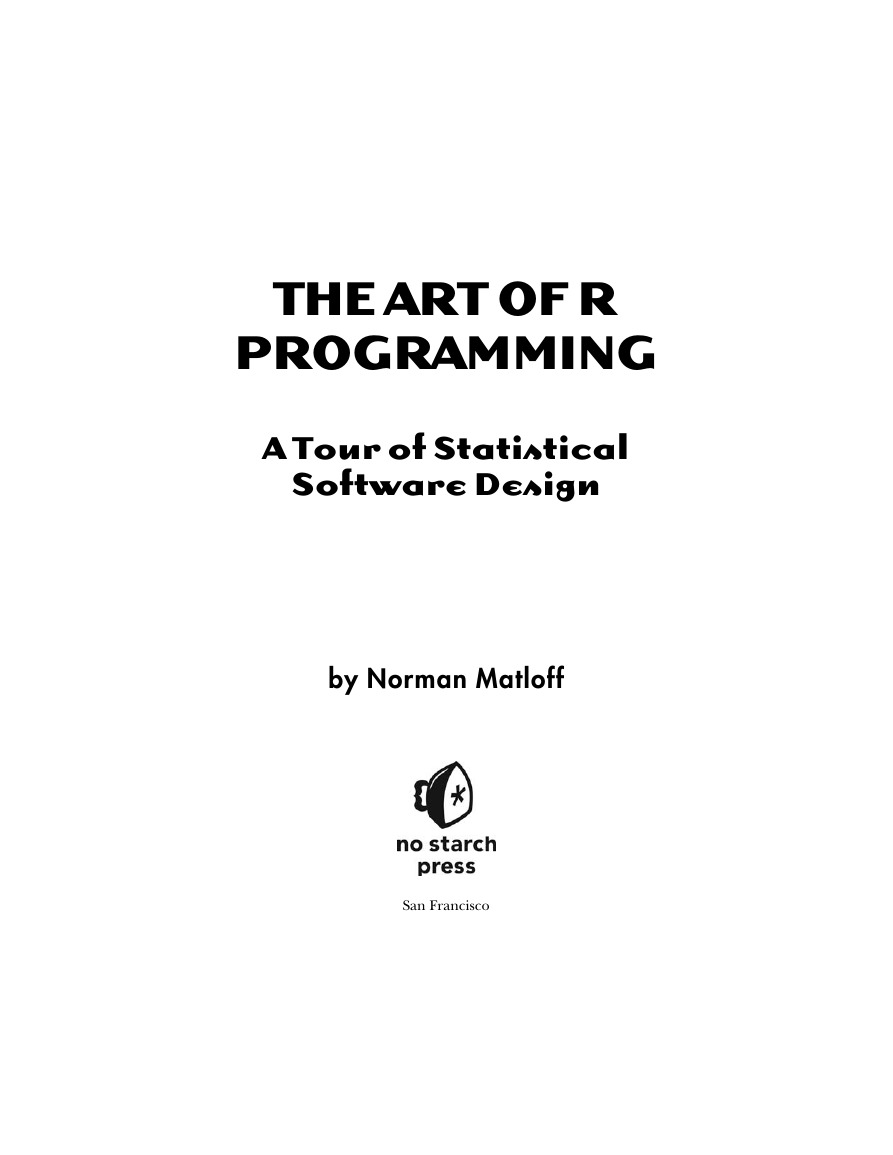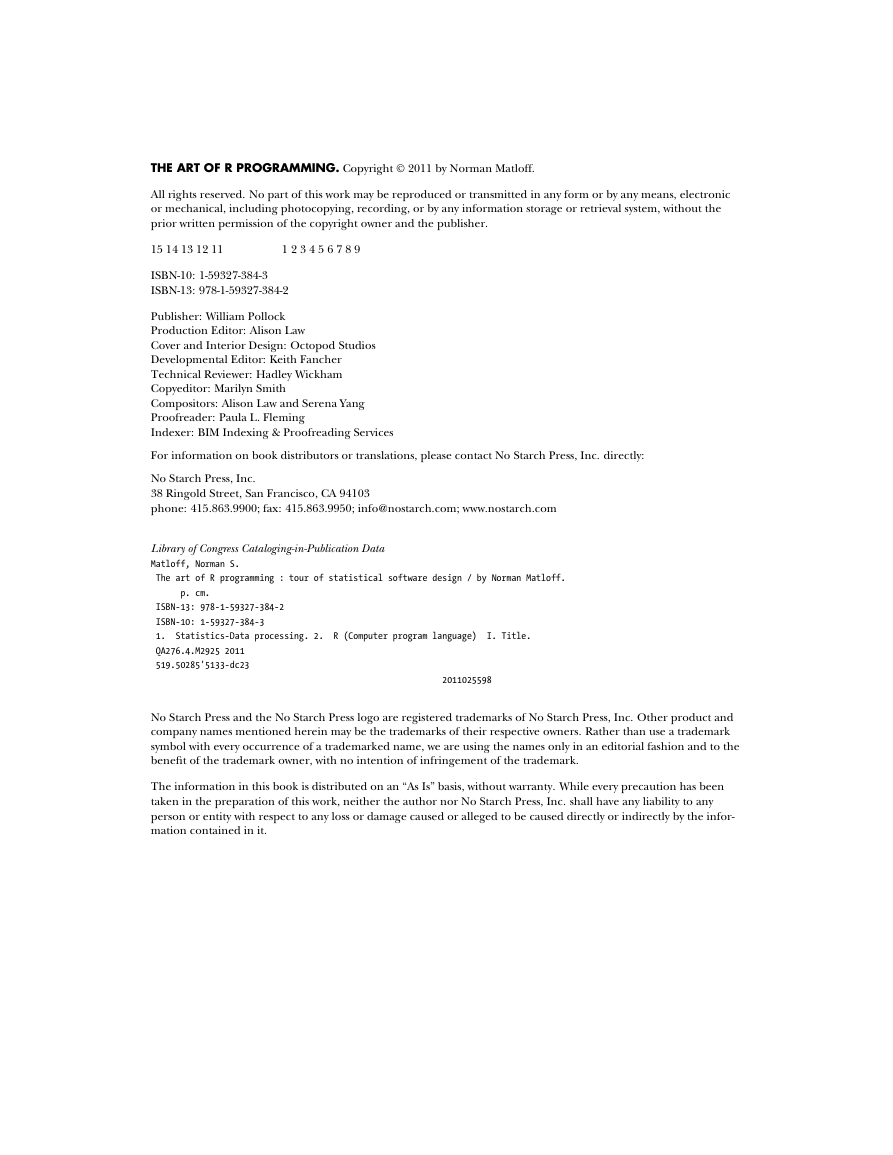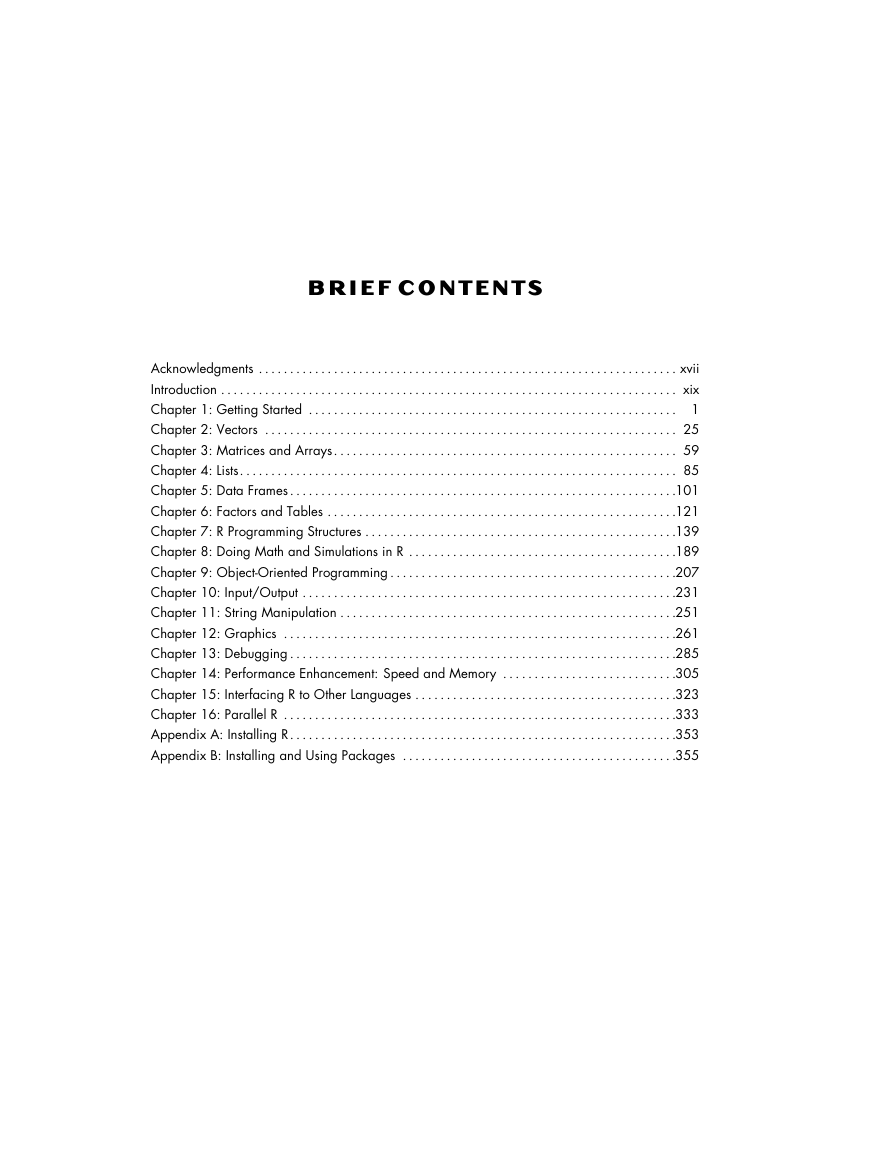Copyright
Brief Contents
Contents in Detail
Acknowledgments
Introduction
Why Use R for Your Statistical Work?
Whom Is This Book For?
My Own Background
1: Getting Started
1.1 How to Run R
1.2 A First R Session
1.3 Introduction to Functions
1.4 Preview of Some Important R Data Structures
1.5 Extended Example: Regression Analysis of Exam Grades
1.6 Startup and Shutdown
1.7 Getting Help
2: Vectors
2.1 Scalars, Vectors, Arrays, and Matrices
2.2 Declarations
2.3 Recycling
2.4 Common Vector Operations
2.5 Using all() and any()
2.6 Vectorized Operations
2.7 NA and NULL Values
2.8 Filtering
2.9 A Vectorized if-then-else: The ifelse() Function
2.10 Testing Vector Equality
2.11 Vector Element Names
2.12 More on c()
3: Matrices and Arrays
3.1 Creating Matrices
3.2 General Matrix Operations
3.3 Applying Functions to Matrix Rows and Columns
3.4 Adding and Deleting Matrix Rows and Columns
3.5 More on the Vector/Matrix Distinction
3.6 Avoiding Unintended Dimension Reduction
3.7 Naming Matrix Rows and Columns
3.8 Higher-Dimensional Arrays
4: Lists
4.1 Creating Lists
4.2 General List Operations
4.3 Accessing List Components and Values
4.4 Applying Functions to Lists
4.5 Recursive Lists
5: Data Frames
5.1 Creating Data Frames
5.2 Other Matrix-Like Operations
5.3 Merging Data Frames
5.4 Applying Functions to Data Frames
6: Factors and Tables
6.1 Factors and Levels
6.2 Common Functions Used with Factors
6.3 Working with Tables
6.4 Other Factor- and Table-Related Functions
7: R Programming Structures
7.1 Control Statements
7.2 Arithmetic and Boolean Operators and Values
7.3 Default Values for Arguments
7.4 Return Values
7.5 Functions Are Objects
7.6 Environment and Scope Issues
7.7 No Pointers in R
7.8 Writing Upstairs
7.9 Recursion
7.10 Replacement Functions
7.11 Tools for Composing Function Code
7.12 Writing Your Own Binary Operations
7.13 Anonymous Functions
8: Doing Math and Simulations in R
8.1 Math Functions
8.2 Functions for Statistical Distributions
8.3 Sorting
8.4 Linear Algebra Operations on Vectors and Matrices
8.5 Set Operations
8.6 Simulation Programming in R
9: Object-Oriented Programming
9.1 S3 Classes
9.2 S4 Classes
9.3 S3 Versus S4
9.4 Managing Your Objects
10: Input/Output
10.1 Accessing the Keyboard and Monitor
10.2 Reading and Writing Files
10.3 Accessing the Internet
11: String Manipulation
11.1 An Overview of String-Manipulation Functions
11.2 Regular Expressions
11.3 Use of String Utilities in the edtdbg Debugging Tool
12: Graphics
12.1 Creating Graphs
12.2 Customizing Graphs
12.3 Saving Graphs to Files
12.4 Creating Three-Dimensional Plots
13: Debugging
13.1 Fundamental Principles of Debugging
13.2 Why Use a Debugging Tool?
13.3 Using R Debugging Facilities
13.4 Moving Up in the World: More Convenient DebuggingTools
13.5 Ensuring Consistency in Debugging Simulation Code
13.6 Syntax and Runtime Errors
13.7 Running GDB on R Itself
14: Performance Enhancement: Speed and Memory
14.1 Writing Fast R Code
14.2 The Dreaded for Loop
14.3 Functional Programming and Memory Issues
14.4 Using Rprof() to Find Slow Spots in Your Code
14.5 Byte Code Compilation
14.6 Oh No, the Data Doesn’t Fit into Memory!
15: Interfacing R to Other Languages
15.1 Writing C/C++ Functions to Be Called from R
15.2 Using R from Python
16: Parallel R
16.1 The Mutual Outlinks Problem
16.2 Introducing the snow Package
16.3 Resorting to C
16.4 General Performance Considerations
16.5 Debugging Parallel R Code
Appendix A: Installing R
A.1 Downloading R from CRAN
A.2 Installing from a Linux Package Manager
A.3 Installing from Source
Appendix B: Installing and Using Packages
B.1 Package Basics
B.2 Loading a Package from Your Hard Drive
B.3 Downloading a Package from the Web
B.4 Listing the Functions in a Package
Index
UPDATES
















 2023年江西萍乡中考道德与法治真题及答案.doc
2023年江西萍乡中考道德与法治真题及答案.doc 2012年重庆南川中考生物真题及答案.doc
2012年重庆南川中考生物真题及答案.doc 2013年江西师范大学地理学综合及文艺理论基础考研真题.doc
2013年江西师范大学地理学综合及文艺理论基础考研真题.doc 2020年四川甘孜小升初语文真题及答案I卷.doc
2020年四川甘孜小升初语文真题及答案I卷.doc 2020年注册岩土工程师专业基础考试真题及答案.doc
2020年注册岩土工程师专业基础考试真题及答案.doc 2023-2024学年福建省厦门市九年级上学期数学月考试题及答案.doc
2023-2024学年福建省厦门市九年级上学期数学月考试题及答案.doc 2021-2022学年辽宁省沈阳市大东区九年级上学期语文期末试题及答案.doc
2021-2022学年辽宁省沈阳市大东区九年级上学期语文期末试题及答案.doc 2022-2023学年北京东城区初三第一学期物理期末试卷及答案.doc
2022-2023学年北京东城区初三第一学期物理期末试卷及答案.doc 2018上半年江西教师资格初中地理学科知识与教学能力真题及答案.doc
2018上半年江西教师资格初中地理学科知识与教学能力真题及答案.doc 2012年河北国家公务员申论考试真题及答案-省级.doc
2012年河北国家公务员申论考试真题及答案-省级.doc 2020-2021学年江苏省扬州市江都区邵樊片九年级上学期数学第一次质量检测试题及答案.doc
2020-2021学年江苏省扬州市江都区邵樊片九年级上学期数学第一次质量检测试题及答案.doc 2022下半年黑龙江教师资格证中学综合素质真题及答案.doc
2022下半年黑龙江教师资格证中学综合素质真题及答案.doc